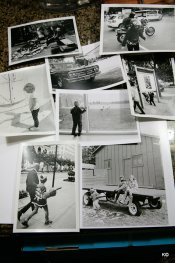Ko.Fe.
Member
My wife told me this weekend what most of my prints are grey and nothing stands out like black and white. I'm desperate to make her accepting my prints, otherwise I'll have to step into house renovations projects, which I'm totally incapable off. 
But I have no idea how to do prints with rich black and white, like white. I could get it done by manipulating of scans in PP, but I don't like computerised route.
I sorted out safelight for now. Paid for regular metal box and Kodak filter, tested it. It is fine.
My prints have all of the details on skin and in the shadows. If I'm trying to print on fresh (I believe not fogged) RC MG paper with lot more contrast, but shadows turning into black and faces are turning white with no skin details.
My most contrast prints are coming with very old Agfa-Brovira #4 FB 5x7 paper. Faces contains skin, but black is more deep. I could get enough of the contrast at same old paper but #2 (contrast grade) version as well.
On 8x10 (fresh RC or old 8x10 FB) I can't.
Would it be my basic, little Vivitar enlarger itself? I have good lenses for it. I'm still waiting for lens board to be able to try D5 beast for first time.
Should I simply ditch RC papers and find fresh analog to Agfa-Brovira single grade FB paper?

But I have no idea how to do prints with rich black and white, like white. I could get it done by manipulating of scans in PP, but I don't like computerised route.
I sorted out safelight for now. Paid for regular metal box and Kodak filter, tested it. It is fine.
My prints have all of the details on skin and in the shadows. If I'm trying to print on fresh (I believe not fogged) RC MG paper with lot more contrast, but shadows turning into black and faces are turning white with no skin details.
My most contrast prints are coming with very old Agfa-Brovira #4 FB 5x7 paper. Faces contains skin, but black is more deep. I could get enough of the contrast at same old paper but #2 (contrast grade) version as well.
On 8x10 (fresh RC or old 8x10 FB) I can't.
Would it be my basic, little Vivitar enlarger itself? I have good lenses for it. I'm still waiting for lens board to be able to try D5 beast for first time.
Should I simply ditch RC papers and find fresh analog to Agfa-Brovira single grade FB paper?
Last edited by a moderator:













